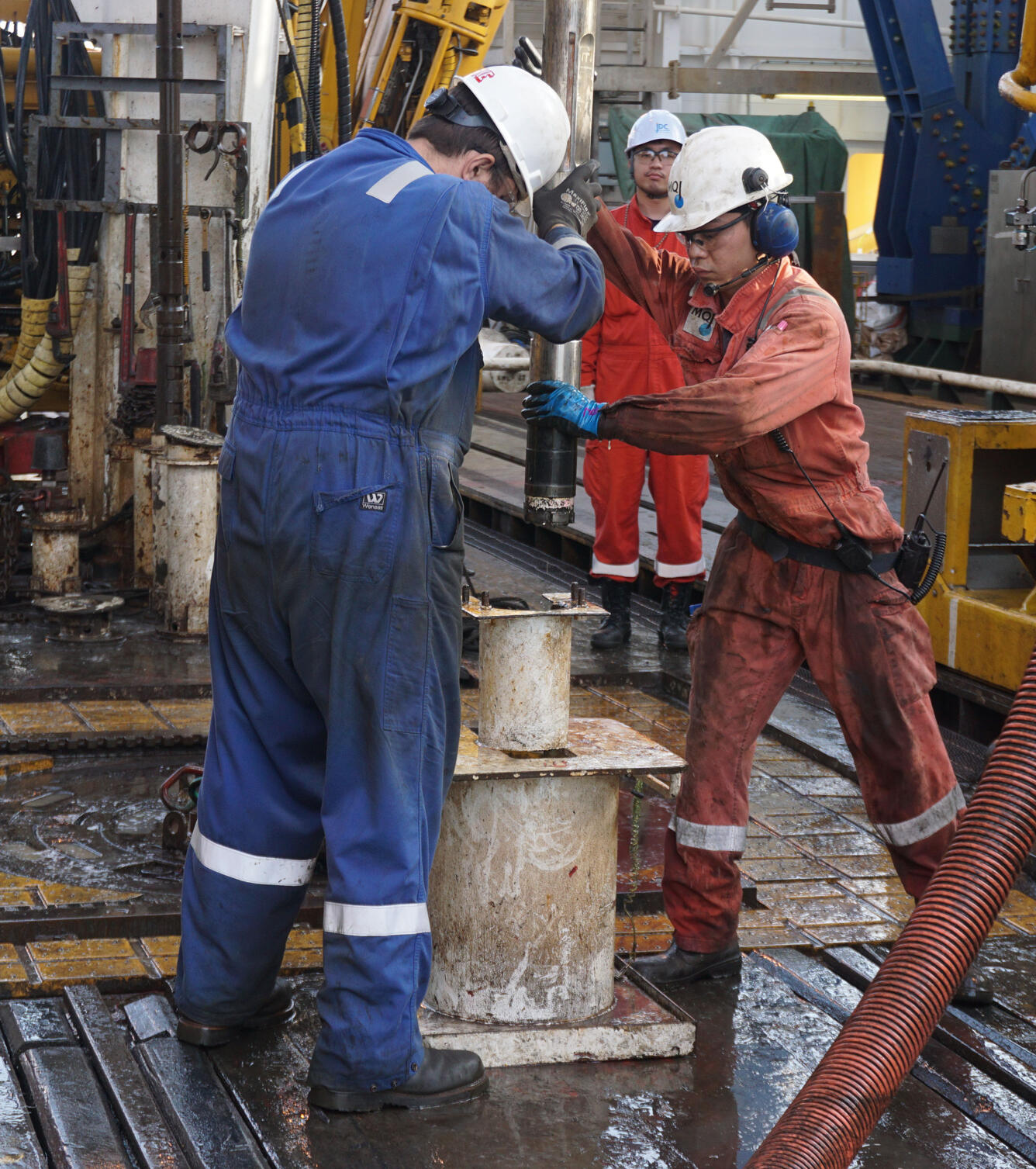Special Issue of Indian Ocean Gas Hydrate Expedition
The USGS and its research partners in India and Japan have reported on one of the most extensive data sets ever collected on the occurrence of natural gas hydrate.
These data are the focus of a Journal of Marine and Petroleum Geology (October, 2019; Volume 108) special issue that is devoted to a multinational research expedition undertaken in the Indian Ocean. The special issue includes four featured reports that summarize the 42 technical reports that describe in detail the findings of this milestone expedition.
Natural gas hydrate is a naturally occurring, ice-like combination of natural gas and water found in the world’s oceans and polar regions. Because gas hydrate is a concentrated form of natural gas and is found along most of the world’s continental margins, numerous countries are investigating the possibility of extracting gas from these deposits to meet resource needs.
The Indian National Gas Hydrate Program Expedition 02 (NGHP-02), undertaken in 2015 by the Government of India in partnership with scientists from Japan and the United States (including the USGS), discovered large, highly enriched accumulations of natural gas hydrate in the Bay of Bengal. The research expedition was the second cooperative exploration for gas hydrate potential in the Indian Ocean. The first expedition in 2006 was also a partnership between scientists from India and the United States.
The enriched hydrate accumulations discovered during NGHP-02 were the first Indian Ocean occurrences that may have the potential to produce enough natural gas to be relevant for additional energy resource studies. Significant technical challenges remain with regard to production scenarios, depending especially on the location, geology, and amount of hydrate in the reservoir. Studies of existing gas hydrate production technologies have shown that natural gas can be more easily produced from highly concentrated gas hydrate occurrences.
The results of downhole geophysical logging, sediment coring and formation pressure testing operations during the 2015 NGHP-02 expedition confirmed the presence of extensive sand-rich depositional systems throughout the deep-water portions of the Krishna-Godavari and Mahanadi Basins. Two areas of the Krishna-Godavari Basin appear to contain substantial gas hydrate accumulations in sand-rich systems that represent ideal candidate sites for future gas hydrate production testing.
The journal’s special issue presents a comprehensive synthesis of the geologic, geophysical, geochemical, and physical property data from the NGHP-02 expedition. The studies not only enhance understanding of Indian Ocean gas hydrate systems, but also provide lessons applicable to global gas hydrate reservoirs. Another major achievement of the research expedition was testing geologic and geophysical models that predicted where gas hydrates that could yield natural gas might be found. The locations and amounts of enriched hydrate accumulations discovered during NGHP-02 closely matched the predictions of reservoir exploration models.
The USGS contributed to every phase of NGHP-02 effort. Shipboard operations and science program were coordinated by USGS scientist Timothy Collett, while William Waite assisted with all aspects of the conventional- and pressure-coring program laboratory studies; John Pohlman, Pamela Swarzenski, and Tom Lorenson contributed to the NGHP-02 geochemistry program.
In addition, after the expedition ended, these USGS scientists, along with Junbong Jang and Laura Stern, participated in extensive post-drilling, shore-based analyses by measuring the geotechnical properties of recovered pressure cores, acquiring scanning electron microscopy imagery of sediments, and conducting advanced geochemical analyses. USGS scientists either authored or coauthored 17 of the 46 summary and technical reports included in the NGHP-02 special issue. Collett and Waite, as well as U.S. Department of Energy (DOE) scientist Ray Boswell also contributed to the editorial responsibilities of the NGHP-02 special issue.
The international team of scientists was led by the Oil and Natural Gas Corporation Limited of India and the Directorate General of Hydrocarbons on behalf of the Ministry of Petroleum and Natural Gas India, in cooperation with the USGS, DOE, the Japanese Drilling Company, and the Japan Agency for Marine-Earth Science and Technology. In addition, the USGS worked closely with the National Institute of Advanced Industrial Science and Technology Japan on the analysis of pressure core samples collected from sand reservoirs with high gas hydrate concentrations.
More information about the Indian National Gas Hydrate Program Expedition 02 can be found here. The USGS has been active in gas hydrate research for more than three decades. The seminal contributions of the USGS Gas Hydrates Project include participating in and sometimes managing large-scale drilling projects that investigate the resource potential of gas hydrates in Alaska, offshore Korea, and the Gulf of Mexico; providing unique research capabilities and special high-pressure laboratory facilities to study hydrates in conditions close to their natural state; producing assessments of technically-recoverable gas hydrate resources; characterizing the physical properties of hydrate bearing sediments to constrain reservoir properties; unraveling the possible synergies between gas hydrate breakdown and environmental change; and acquiring data to image the distribution of these deposits on the U.S. Atlantic, Gulf of Mexico, and Beaufort Sea margins.







